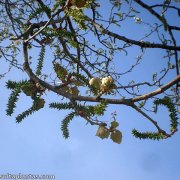Care of the tree Populus alba or White poplar |
|
The genus Populus, family Salicaceae, includes 40 species of trees native to cold and temperate areas of the Northern Hemisphere. Some species are: Populus alba, Populus nigra, Populus tremula, Populus mexicana, Populus tremuloides, Populus deltoides, Populus lasiocarpa. Common names: White poplar, Silver poplar, Abele, Silverleaf poplar. This species is native to Morocco but is distributed throughout Europe and Central Asia. They are fast growing dioecious deciduous trees with columnar bearing that reach 30 meters (98.4 feet) in height. The bark is whitish gray. The leaves have 5 lobes, the edge is serrated and are bright green on the hay and tomentose on the underside. The flowers are hanging catkins that have no decorative interest; appear before the leaves. White poplar is used to fix riverbanks, next to ponds and water courses, as isolated specimens and in groups in the garden. It should not be planted near buildings due to its powerful roots. Populus alba needs full sun or light shade exposure. It resists frost well. Silver poplar grows in any type of soil (even limestone, poor or clay soils) but prefers deep soils that contain abundant organic matter. Water frequently so that the substrate is always damp. White poplar does not resist drought. Fertilize with organic and mineral fertilizer at the time of planting (in autumn or spring) and with organic matter every year in spring. Prune the suckers that it can produce at the base. Populus alba can be attacked by mealybugs, aphids and caterpillars especially if it suffers from drought. Silverleaf poplar is propagated by apical cuttings in summer and by separation of suckers in spring. |
Images of the tree Populus alba or White poplar |
Find plants
Populus alba or White poplar | Care and Growing
© 2025 FavThemes





